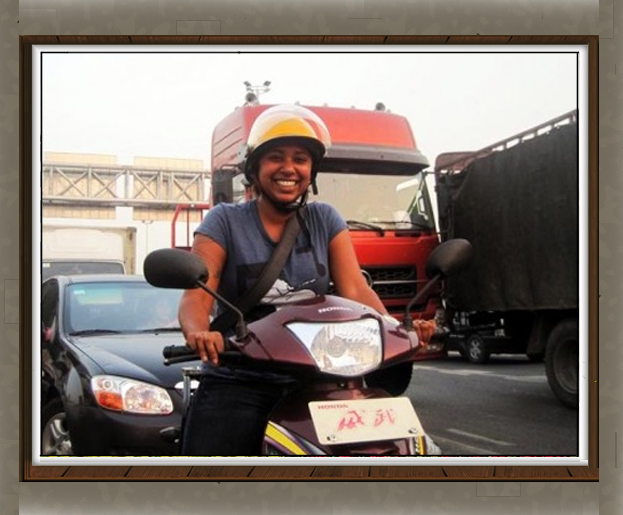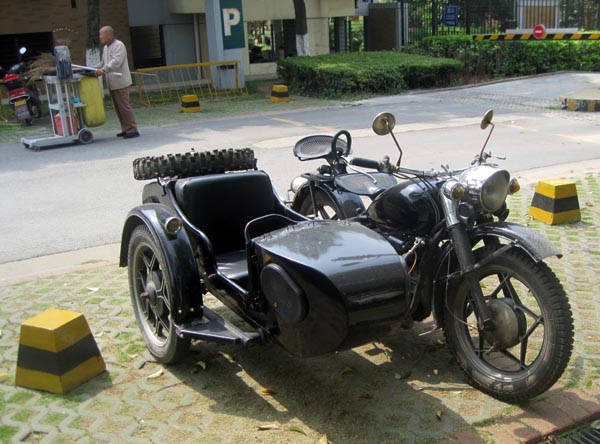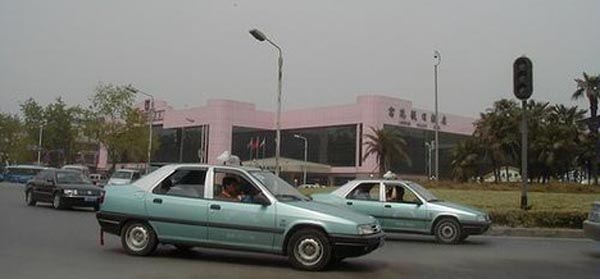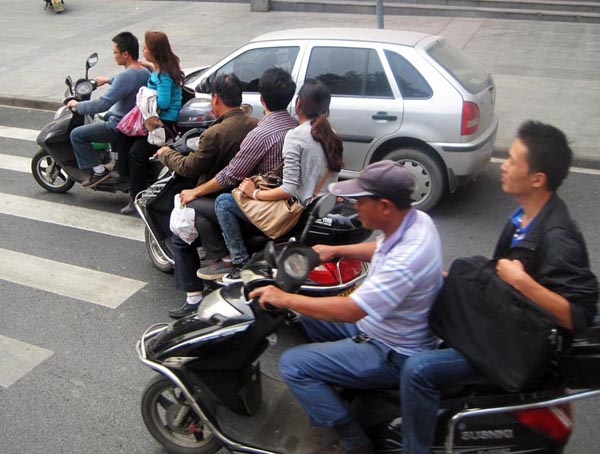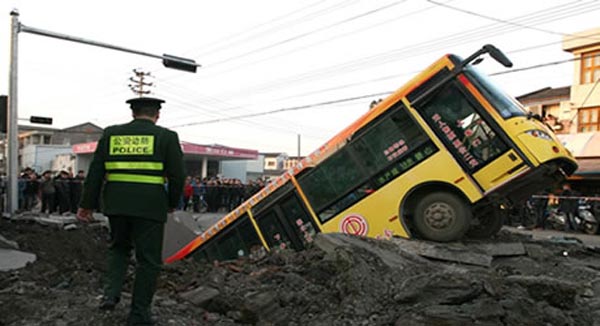So You Want to Drive in China?
You’ve seen the videos. You’ve read the blogs. You’ve heard the stories. Is driving in China really as bad as it is made out to be. Hell, yeah! I have decided if you can drive here, you can drive anywhere. After four years of battling the traffic on various two-wheeled vehicles, I have built up a bit of experience on the front line. With my Chang Jiang 750 sidecar bike, I have to drive in the traffic away from the safety of the scooter lanes that run parallel to almost every city road.. It is just too big to maneuver along these lanes that are sometimes choked with parked cars and street vendors. This brief article is geared towards scooter and motorcycle riding but if you are courageous enough to rent or buy a car here, most of the tips are applicable as well.
Training
If you have time, and are planning on sticking around in China for awhile, use the taxis as a training ground. As they whisk you through traffic at breakneck speed, take mental notes of how the driver manages to avoid pretty much every moving object in his path. Look around you and observe the flow of traffic and the minimum distance that is possible between two moving vehicles. Check out how the cabbie manages to predict the movement of any pedestrians and plan his movement to choreograph with theirs. These guys are professionals; in North America they would be signed up on the spot for the international racing circuit. I feel that two or three months of this type of training is probably adequate before you hit the road in your new scooter, motorcycle or car.
Part two of your training involves standing at a busy intersection and observing how vehicles approach this area both mentally and physically. This was part of my motorcycle training in British Columbia. There we were instructed to note the number of cars that don’t notice and/or don’t stop for the red light. Here, it’s all about noticing how many people actually do stop. It’s a small number at many intersections, especially the less busy ones.
Obtaining a Driving License
So the big day arrives and you decide it is time to buy something with wheels and an engine. You are presented with several choices when it comes to a driving license. You can forget about it all together and just drive without a license like much of the population does. Of course, this opens you up to potential legal problems if you happen to be involved in an accident and don’t have enough cash to pay off the other driver.
You can purchase a counterfeit driving license very easily for under 500RMB. The quality of these licenses is exceptional and many are made in the same offices as the real ones. It is pretty much impossible to tell the difference especially when you note that they even include all the exact hologram replications on the surface.
If money is not an issue, you can order one to be delivered in the mail for anywhere between 3000-6000RMB. These are completely legal and registered with the equivalent of the Chinese Department of Motor Vehicles. A quick trip to your local license bureau will validate its authenticity.
Or, you can actually write the driving test (in English) and if you score over 90%, you will be issued a license equivalent to any valid license you have from your home country. I believe these cost about 100RMB. Before you write the test, you can obtain a CD with over 1500 possible questions to study.
Safety Gear
Are you kidding? You’re in China! When you do your training and ride in a taxi, you will find that there are rarely seat belts available, which makes it pretty hard to buckle up. Most of the drivers are encased in steel tubing or screen mesh. I am not sure if this is to prevent theft or to stop the rear seat passengers from flying into them in case of accidents. If you rent a vehicle, or actually own one, I suppose it will come with seat belts. You could go the extra mile and build the safety mesh as an extra precaution.
Wear a helmet at all times if you are riding a scooter or motorcycle. This is not really for protection but only to stop your close friends from continually saying, “Wear a helmet!.” It gets a little wearing after awhile. I have yet to see a helmet here that comes close to satisfying any safety standards in North America. The inside protective Styrofoam layer is usually so thin as to be useless, for all intensive purposes. They would offer some protection in a minor crash but that is about it. If you really want to wear a good helmet, bring one from your home country. I am sure that are available here somewhere but I have not seen any in the motorcycle shops I have visited.
Who Has the Right-of-Way?
Whoever gets there first! This is probably the most important rule in this country. This applies to every situation in most cities and villages. If there is an empty space on the road ahead of you and it is wide enough to fit your vehicle (don’t forget about the passenger’s legs hanging over each side), go for it. If the car or bus on either side of you is 1cm further ahead than you, it has the right to barge in front of you. There is no mercy to this rule. If you don’t let the person in, there will most certainly be a fender bender because the war of nerves will result in both of you losing the battle. This is the major cause of accidents. Some people don’t just get it and believe they have the right to their lane because they happen to be in it.
There are two or three types of vehicles you must always be aware of; buses, taxis, and large trucks. They do not stop for anything or anybody. At all times, stay out of their way as much as possible. If you decide to squeeze in between them and the curb, be prepared to make a hasty getaway because they will squish you right into never-never land without batting an eye.
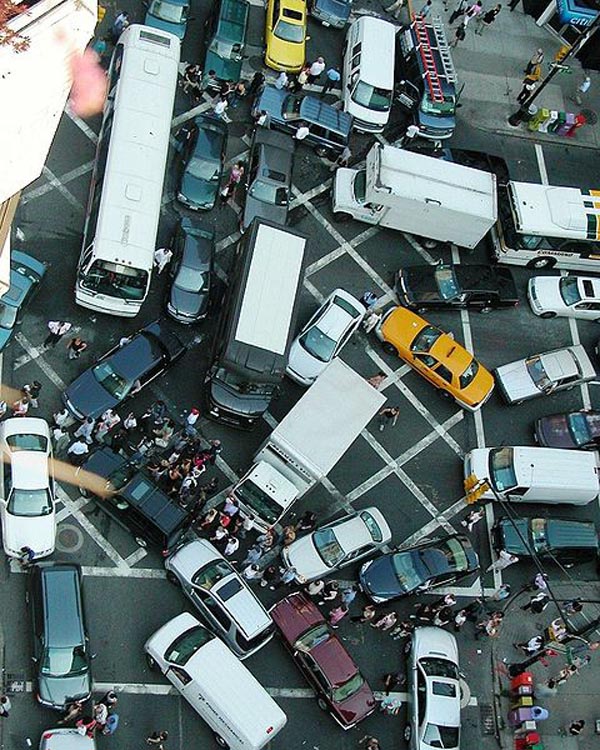
What Do the Lines on the Road Mean?
Absolutely nothing! In most countries, the double line means don’t pass. Here it is meant only as a guide. If there is oncoming traffic that is at least five or six car lengths ahead, then they definitely have the right-of-way. But, hey, if you and your followers have time at a busy intersection to get to the front by crossing the double line and moving to the front before the oncoming traffic starts moving, go ahead. What are they going to do, smash into you? Of course not! They’ll just have to move around all of you or let you go first to unblock the lane. Why let an empty lane just sit there? Fair is fair. This rule applies anywhere; if the lane is free, use it!
Intersections
Now this is serious business. It takes a lot of experience, skill and nerve to negotiate a typical Chinese intersection. They are not for the weak-of-heart. It’s almost like you need a course in choreography before tackling these traffic mayhems. The most important thing is to remember the right-of-way rule above. Let’s divide it into three sections; before, during and after.
1. Approaching
You see an intersection ahead and the light is green. Don’t slow down but do look at roads leading to the intersection. If you see oncoming traffic from any direction and are certain you can get there first, just bomb through the light with your horn blasting to warn everyone that “you are coming through” and/or “get the hell out of my way.”
If the light is red, you have a few options. If there is a lot of traffic you can actually stop, but that would be a last resort. If there are pedestrians crossing anywhere towards the direction you are traveling, move into the pack with your bike and follow them. You can weave between the cars moving at right angles to you if you time everything just right. This is where the experience and nerve come into play. If there is not a lot of traffic, you can 1) just ride straight through or 2) fake a right turn and then weave back into the forward facing lane and carry on in the direction you were traveling.
2. At the intersection
So you had to stop and you are now way behind a line of cars waiting for the light to change. Don’t give up; you have a lot of choices. Your only goal at this point is to move as far towards the light as you can before it turns green. Remember that your lane is not the only path you can take. Think about the double-line discussion above. If you can maneuver your vehicle to the lane of oncoming traffic that is probably fairly empty at this point, then by all means, do it. You will probably not be the leader but just following several other vehicles that are doing the same thing. If there is any way to squeeze between the cars and trucks ahead of you, you might be able to gain a few car lengths while waiting for the light to change. Finally, there is always the sidewalk or scooter lane, whichever is more accessible. At rush hour, sidewalks become another lane of traffic in most places. Again, the empty space rule comes into play. The only place my wife was ever run over was on the sidewalk. A sedan with a family of four ran over her foot. They honked as they did it, which was a friendly thing to do. Luckily, she did not suffer any damage except a beautiful tire impression on her boot.
3. Leaving the intersection
Again, a crucial part of the driving process. The intersection will probably still be choked with cars and trucks when it is your turn to go. Just put your hand on the horn and bully your way through. It is your turn and you have to let everybody know it! It takes most drivers a minute or so to realize that their time is up and they really do have to stop and let the others go for a bit. And all the vehicles that have blocked up every oncoming lane, and more, have to have time to get out of the way.
Potholes
Potholes are the bane of Chinese drivers. When I say pothole, I don’t really mean pothole, I mean bottomless chasms in the road or sidewalk. These can be caused by large chunks of asphalt sinking or disappearing overnight for no explicable reason. Another common sight are manholes that are used to access waterworks or underground wiring. The city workers just don’t always place the covers back on when they are finished. If they are working in the same spot for a few days, the covers most certainly won’t be replaced until a few days after they have finished. Why would they put them back on? They will just have to take them back off every time they want to climb back down into the hole. Now, to be fair, the employees do sometimes stick a little branch in them to warn oncoming motorists but these soon fall into the holes or blow away. This is the main reason I do not drive at night if I can possibly help it.
One of my Chinese friends told me a story concerning manhole covers. When he was a little kid walking along the sidewalk with his mom, he fell into one of these holes. She turned around and he had completely disappeared. It was deep enough that he had totally dropped out of sight! Luckily, he got away with only a few scrapes and bruises!
And a few last minute thoughts;
Emergency Vehicles
Nobody else pulls over for them, why should you?
Speed Limits
If they exist, it’s news to me. As someone once told me, how can the cops keep on top of drivers in a city of ten or fifteen million?
If You Are In An Accident?
Don’t get the police involved unless you absolutely have to. Try not to speak any Chinese, even if you can. If it is your fault, try to determine how much money the person expects you to pay him or her to send them on their way. If it is their fault…..good luck!
If you run into an animal in the countryside, there is an unwritten payment rule. The size and usefulness of the animal will determine how much you will be expected to pay in compensation. Killing a small rabbit or chicken will cost you a lot less than injuring a cow or goat.
Conclusion
You may believe that was a tongue-in-cheek look at driving in this country. Anywhere else, it would be. Here, most of what I said above holds true! Having said all this, I really do love driving here. It is necessary at all times to be aware of everything and everybody in a 360 degree radius. But if you survive the steep learning curve, driving will get you to many places you wouldn’t normally be privy to.

